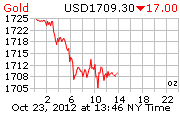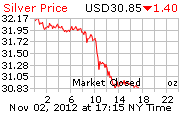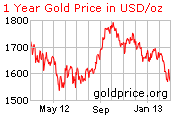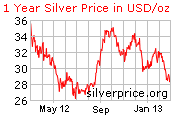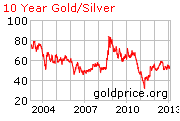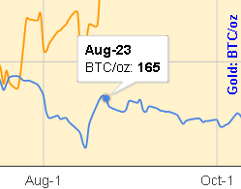Archive
The Greatest Risk for Gold Investors
By Jeff Clark | BIG GOLD
While we’re convinced that our gold and silver investments will pay off, they don’t come without risk. What do you suppose is the biggest risk we face? Another 2008-style selloff? Gold stocks never breaking out of their funk? Maybe a depression that slams our standard of living?
Though those things are possible, we at Casey Research don’t see that as your greatest threat:
“Your biggest risk is not that gold or silver may fall in price. Nor is it that gold stocks could take longer to catch fire than we think. Not even the prospect of the Greater Depression. No, your biggest risk is political. As bankrupt governments get increasingly desperate for revenue, any monetary asset held domestically could be a target. It is absolutely essential that every investor diversify themselves politically. In fact, at this point, it is the one action that should be taken before anything else.” - Doug Casey, September 2011
I know many reading this are prudent investors. You own gold and silver as solid protection against currency debasement, inflation, and faltering economies. You set aside cash for emergencies. You have strong exposure to gold stocks, both producers and juniors, positioned ahead of what is likely the next-favored asset class. You feel protected and poised to profit.
Yet, despite all this preparation, you remain exposed to one of the biggest risks.
Similar to holding a diversified portfolio at a bank without checking the institution‘s solvency, many investors keep their entire stash of precious metals inside one political system without considering the potential trap they‘ve set for themselves. While storing some of your gold outside your home country is not a panacea, it does offer one important thing: another layer of protection.
Consider the exposure of the typical US investor:
- systemic risk, because both the bank and broker are US domiciled
- currency risk, as virtually every transaction is made in US dollars
- political risk, because they are left totally exposed to the whims of a single government
- economic risk, by being vulnerable to the breakdown of a single economy
Viewed in this context, the average US investor has minimal diversification.
The remedy is to internationalize the storage of some of your precious metals. This act reduces four primary risks:
Confiscation: We don‘t know the likelihood of another gold confiscation. But we do know that things are working against us - particularly for US citizens. With $14.7 trillion of debt and $115 trillion of unfunded liabilities, the US government will likely pursue heavy-handed solutions. Under the 1933 FDR “gold confiscation” in the US (the executive order was actually a forced delivery of citizens‘gold in exchange for cash), foreign-held gold was exempted.
Capital Controls: Many Casey editors think some form of capital controls lie ahead, limiting or eliminating a citizen‘s ability to carry or send money abroad. If enacted, all your capital would be trapped inside the US and at the mercy of whatever taxing and regulating schemes the government might concoct. Although you might be able to leave the country, your assets could not travel with you.
Administrative Action: There are plenty of horror stories of asset seizure by a government agency without any notice or due process, possibly leaving the victim without the means to mount a legal defense. Having some gold or silver stored elsewhere provides what could be your only available source of funds in such a scenario.
Lack of Personal Control: Having gold and silver stored elsewhere adds to your options. You will have a source of funds available for business, entrepreneurial pursuits, investment, or pleasure.
Foreign-held assets also require greater awareness and planning:Notice above we said these risks can be reduced, not eliminated. There is no perfect solution; US persons could, for example, be compelled to pay a “wealth tax” on assets held worldwide, or even repatriate them in a worst-case scenario. Absent a crystal ball, the political diversity of asset location is an essential strategy against an uncertain future.
- Access to your metal or sale proceeds may not be quick. Therefore, this option is for those with some gold and silver stored at or near home. We do not recommend storing all your precious metals overseas; that defeats one of its purposes, to have it handy for an emergency.
- While we think the US poses the greatest threat, a foreign government could move to control certain assets as well. The risk varies by country and is generally greater within the banking system than with private vaulting facilities.
- Understanding and complying with reporting requirements is essential.
The bottom line, though, is that foreign-held precious metals can mitigate risk and give you more options. And as your metal holdings grows, diversification becomes more crucial.
Given our current rapacious climate, it‘s likely that simply buying gold won‘t be enough. We strongly suggest every investor diversify one‘s bullion storage outside their current political regime. The option may not be available someday, leaving you vulnerable without a secondary source of bullion.
We advise taking advantage of the opportunity before it is gone.
[One way to internationalize your bullion is to use a safe deposit box in a second country; however, this requires traveling to the institution to handle the paperwork and organizing the transport of your bullion... and the contents of a safe deposit box aren't insured. Other programs will store gold; but the metal is often held in the form of fractional ownership in a 400-oz. bar and not specific coins and bars held in your name. A better solution is to store your bullion in a non-bank depository, outside your home country, without shared ownership, and do it for a reasonable fee. We found a program that provides all those things; and it offers BIG GOLD readers six months' free gold and silver storage in a Canadian vault. A risk-free, three-month trial subscription to BIG GOLD will qualify you for that deal... plus all the expert analysis and actionable investment advice packed into each issue.]
Related Articles:
Suicide of the Saver
Submitted by Adrian Ash | BullionVault
-
Savers and pensioners! Your murderers need no revolution to storm your stately homes…
SO IT’S NOW 100 years since Great Britain established its welfare state, writes Adrian Ash online gold market BullionVault.
Shortly after, and as the First World War kicked off, Britain then abandoned the free exchange of bullion for notes under the classical Gold Standard. Those 3 events were a long way from simple coincidence, of course. But 100 years later, it is the monetary revolution which feels most pressing today.
Political fighting over the welfare state is hotting up, but a European shooting match looks unlikely (for now). Whereas UK savers and retirees risk getting slaughtered, alongside their peers on the continent, across North America and pretty much everywhere else.
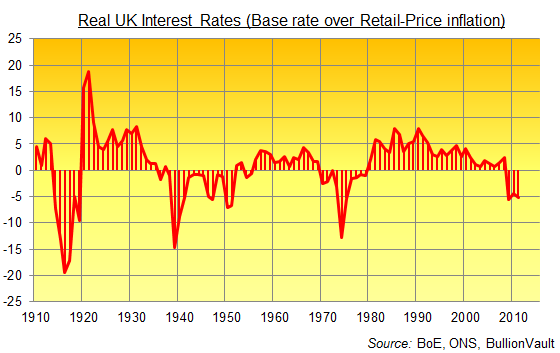
Compared to the previous 100 years, real UK interest rates – the returns paid to cash deposits over and above inflation – have been atrocious since 1911. Averaging less than 0.9% per year, they’ve been a fraction of the 4.4% averaged in the 100 years starting in 1811, just after the British Parliament’s Bullion Committee recommended a full return to gold following the Napoleonic Wars, setting in train the global Gold Standard run from London until the start of World War I.
Enough ancient history; fast forward to today, and the UK’s real rate of interest is now the worst since 1975, back when inflation was running well into double digits but at least the central bank made a pretence of addressing it, setting a nominal base rate of 11%. Last month’s inflation reading was only a 20-year high, but all-time record-low interest rates make cash such a losing proposition, savers are actively paying to hold cash in the bank. And these unsecured creditors are lending to institutions whose “underlying problem is one of solvency not liquidity” as Bank of England governor Mervyn King himself put it in a speech this week.
Losing real value by holding money with insolvent banks sounds like financial suicide. Which for today’s moneyed classes – those millions of savers, pensioners and would-be retirees raised by the welfare state – should sound uncomfortably like the “euthanasia of the rentier” hoped for in the mid-1930s by J.M.Keynes, apostle of deficit spending (and nemesis of the Gold Standard), and slowly put into practice after World War Two by decades of sub-zero real interest rates. Taxation of unearned income peaking at 98% sure helped, too.
“Interest today rewards no genuine sacrifice, any more than does the rent of land,” wrote Keynes in 1936, just ahead of that “depression within a depression” which forced economists to coin a new term, “recession”.
“The owner of capital can obtain interest because capital is scarce,” Keynes went on, “just as the owner of land can obtain rent because land is scarce. But whilst there may be intrinsic reasons for the scarcity of land, there are no intrinsic reasons for the scarcity of capital…I see, therefore, the rentier aspect of capitalism as a transitional phase which will disappear when it has done its work…The euthanasia of the rentier, of the functionless investor, will be nothing sudden, merely a gradual but prolonged continuance of what we have seen recently in Great Britain, and will need no revolution.”
Today’s savers might not see themselves as “functionless investors” anymore than they see themselves as stuffed-shirt aristocrats wielding “the cumulative oppressive power of the capitalist to exploit the scarcity-value of capital”. But the owner of capital, however modest, can no longer obtain interest, that much is plain. Because capital is no longer scarce. Solvency is. And there’s a whole heap of 21st-century rentiers waiting to put out of their misery yet.
Looking to Buy Gold today…?
Suicide of the Saver
by Adrian Ash
BullionVault
Wednesday, 19 October 2011
Savers and pensioners! Your murderers need no revolution to storm your stately homes and
palaces…
IT’S NOW 100 years since Great Britain established its welfare state. Shortly after, and as
the First World War kicked off, it abandoned the free exchange of bullion for notes under the
classical Gold Standard.
Those 3 events were far from unrelated, but 100 years later it’s the monetary shift which
feels most pressing right now. Yes, political fighting over the welfare state is hotting up,
but a European shooting match looks unlikely (for the time being). Whereas UK savers and
retirees, like their peers across the continent, in North America and pretty much everywhere
else, are getting slaughtered.
Compared to the previous 100 years, real UK interest rates – the returns paid to cash deposits
over and above inflation – have been atrocious since 1911. Averaging less than 0.9% per
year, they’ve been a fraction of the 4.4% averaged in the 100 years starting in 1811, just after
the British Parliament’s Bullion Committee recommended a full return to gold following the
Napoleonic Wars, setting in train the global Gold Standard run from London until the start of
World War I.
Enough ancient history; fast forward to today, and the UK’s real rate of interest is now the
worst since 1975, back when inflation was running well into double digits but at least the
central bank made a pretence of addressing it, setting a nominal base rate of 11%. Last
month’s inflation reading was only a 20-year high, but all-time record-low interest rates make
cash such a losing proposition, savers are actively paying to hold cash in the bank. And these
unsecured creditors are lending to institutions whose “underlying problem is one of solvency
not liquidity” as Bank of England governor Mervyn King himself put it in a speech last night.
Losing real value by holding money with insolvent banks sounds like financial suicide.
Which for today’s moneyed classes – those millions of savers, pensioners and would-be
retirees raised by the welfare state – should sound uncomfortably like the “euthanasia of the
rentier” hoped for in the mid-1930s by J.M.Keynes, apostle of deficit spending (and nemesis
of the Gold Standard), and slowly put into practice after World War Two by decades of sub-
zero real interest rates. Taxation of unearned income peaking at 98% sure helped, too.
“Interest today rewards no genuine sacrifice, any more than does the rent of land,” wrote
Keynes in 1936, just ahead of that “depression within a depression” which forced economists
to coin a new term, “recession”.
“The owner of capital can obtain interest because capital is scarce,” Keynes went on, “just
as the owner of land can obtain rent because land is scarce. But whilst there may be intrinsic
reasons for the scarcity of land, there are no intrinsic reasons for the scarcity of capital…I see,
therefore, the rentier aspect of capitalism as a transitional phase which will disappear when it
has done its work…The euthanasia of the rentier, of the functionless investor, will be nothing
sudden, merely a gradual but prolonged continuance of what we have seen recently in Great
Britain, and will need no revolution.”
Today’s savers might not see themselves as “functionless investors” anymore than they see
themselves as stuffed-shirt aristocrats wielding “the cumulative oppressive power of the
capitalist to exploit the scarcity-value of capital”. But the owner of capital, however modest,
can no longer obtain interest, that much is plain. Because capital is no longer scarce. But
solvency is.
Adrian Ash
BullionVault
Stocks, Real Estate, Term Deposit, Bonds and Gold: Which is the best performer since 2000?
Submitted by Adrian Ash | BullionVault
-
Galluping Gold!
1-in-3 Americans say they think gold is best long-term? BullionVault doesn’t buy it…
So ACCORDING TO GALLUP, one in every three Americans now thinks gold is the best long-term investment, writes Adrian Ash at BullionVault.
Kinda makes you wonder where the other two US citizens have been investing since the start of last decade…
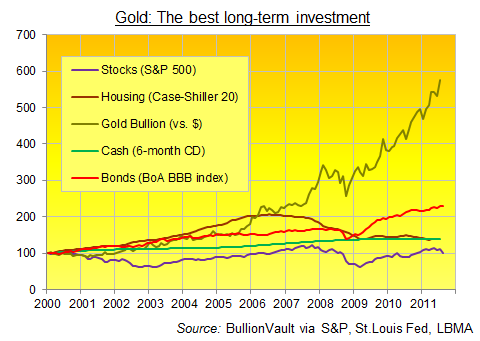
Comparing performance of Gold, Real Estate, Bonds, Cash & Stocks
“Which of the following do you think is the best long-term investment?” asked Gallup in its telephone survey of 1008 adults. You only need eyes to see.
Real estate boomed, then bust as never before. Even with dividends re-invested, stocks have gone nowhere since the start of 2000. Cash has barely beaten inflation (and is set to keep lagging it now the Fed has promised zero interest rates until at least 2013).
So besides gold, only higher-risk corporate debt has managed to deliver a strongly positive real return. But as our chart shows, it’s been way off the pace.
Trouble is, for market-timers trying to see the light in Gallup’s findings, that key phrase “long-term” wasn’t defined in the survey. Is that next year, next decade or not until you are dead or retired? Nor was the other key word – “best” – given much meaning either. Might it mean simply best return, or best return with lower volatility, or simply “best investment” in terms of not blowing up when some other fool defaults on his debt?
Little matter, perhaps. Because either way, the results sure do jar for longer-term gold investors. We’re more used to being laughed at by friends, family, financial advisers and daily papers alike. Standing aside from the crowd was how this bull market in gold got started. And becoming the No.1 popular pick rarely bodes well for an asset’s future performance.
If everyone’s in, who will be left to keep bidding up prices? Well, let’s take a look, using the best available survey of US family savings – the Federal Reserve’s triennial survey of consumer finances (SCF) – last run in 2009, and released in spring 2011.
| Asset | % in Gallup poll | % in Fed SCF |
| Real estate | 19 | 70 (own home) 13 (investment) |
| Stocks/mutual funds | 17 | 29 |
| Bank savings/CDs | 14 | 30 |
| Bonds | 10 | 2.6 |
| Other | 1 | 10.3 (financial) 9.2 (non-finc’l) |
| Retirement accts | ??? | 56 |
| Gold | 34 | ??? |
Source: Gallup, Federal Reserve
Unlike what people think (or say they think), actual investment takes time and money. And according to the Fed’s most recent survey, Joe Public remained a long way from over-invested in gold in 2009. Despite the Gallup findings, there’s no reason to think that’s changed too dramatically since.
The Federal Reserve’s triennial survey didn’t seem to include any questions on gold. So quite which asset-class category Gold Bullion might come under we can’t guess. Case by case for respondents, it would seem to depend on whether they saw gold as a financial or non-financial lump of metal – highly debatable when real estate comes under “non-financial”, while all of the Fed’s “financial” category is either securitized, packaged or actively managed products provided by the financial services industry.
Yes, exposure to the giant SPDR Gold Trust would perhaps show in “stocks/mutual funds”. But short of a revolution in private US allocations over the last two years, far fewer than 1-in-3 adults would seem to be backing gold as the No.1 long-term investment from here.
How about in Dollars and Cents? Taking data from the start of 2000 again, it’s safe conclude that – whatever the number of gold-buying Americans – they haven’t stuck anything like one third of the nation’s private savings into gold bullion. The World Gold Council’s regular updates (see Gold Demand Trends) put net total of bar and coin demand from private US citizens at just shy of 500 tonnes during this bull market to date. On top of that, if we were to assume (wrongly) that the entire SPDR Gold Trust is held to back shares belonging to US investors, that would be another 1230 tonnes, while the iShares IAU trust would add a further 167.5 tonnes. Outside packaged financial services, the two gold market leaders online – BullionVault and GoldMoney – account for 24 tonnes and 18.5 tonnes of gold respectively.
So assuming again (and wrongly again) that every last gram belonged to US savers, we’d therefore get a grand total of 1938 tonnes…which at $111 billion by value today is but a pimple next to the $11 trillion in household net worth suggested by the Fed’s 2009 SCF. (That was back when the stock market traded near 12-year lows, you will recall. And the comparison comes from over-stating US gold demand in all but the “retail bar and coin” data above.)
Now, reviewing these numbers, worse shills and snake-oil salesmen than us might dare to suggest that US citizens have barely begun to Buy Gold, and they clearly would like to. Matching their actual investment to their reported beliefs, the value of privately-invested US gold bullion would need to rise 33 times over (all other things being equal), a move which in itself would confirm gold as the very best long-term investment in history.
Between thought and expression sits the difference between $111bn and $3.7 trillion according to the calculations on BullionVault’s napkin this lunchtime. We’d never be so churlish as to suggest the Gallup poll points to strong US Gold Investment demand ahead of us – not behind – today. But we would point out, yet again, that the gold bubble comes far more in media coverage than in actual investment decisions to date.
The Gallup survey, for instance, was conducted between August 11 and 14th. Gold Prices had just broken above $1800 for the first time ever, on their way to $1900 and making headlines everywhere as the stock market sank. Moreover, interest in gold – like a Google search for “gold price” – doesn’t necessarily end in actual investment. But it does suggest a broader fear of low-growth-plus-rising-inflation – a fear reflected in this week’s Conference Board of US consumer confidence, now sunk to a two-year low. The Economist magazine noted the correlation just this weekend.
“Edward Ritchie, an investment analyst in London…tracks Google searches for the ‘gold price’ as an indicator of economic confidence,” reports The Economist. “[Because] the number of gold-price searches shoots up when consumer confidence dives, and subsides when households perk up again.
“Worryingly, the number of searches has recently vaulted above its 2008 peak, signalling the possibility of a double dip.”
More worrying still, one-in-three Americans – including 26% of 18-29 year olds – just told Gallup they’d prefer a lump of dumb metal over capital risk. Such disillusion with America’s future will no doubt prove either misplaced or self-fulfilling (depending on your proximity to Wall Street or Washington) in due course. But the only sure fact today is that our 21st century depression is clearly reflected in gold’s quickening comeback as a crucial, unique, and un-ignorable asset class.
Buying Gold today? Slash your costs to get the maximum security using world No.1 online, BullionVault…
-
Gold Bullion up 5% for Week, “”Physical, Allocated Gold Preferred”, Short Sell Ban “Is Worst Thing They Can Do”
Submitted by Ben Traynor | BullionVault, 12 Aug ’11
-
Gold Bullion prices dropped nearly 1% in an hour Friday morning in London – hitting a low of $1746 per ounce – as stocks and commodities rallied after yesterday’s decision by four European regulators to ban short selling.
Dollar Gold Bullion Prices however remained 5% up for the week as we head towards the weekend.
Silver Bullion Prices meantime hit $38.70 per ounce around lunchtime – a 1% gain for the week.
“The gold physical market seems to believe that gold will move still higher soon,” reckons Walter de Wet, commodities strategist at Standard Bank.
“This, combined with seasonal demand which should start picking up soon too, is providing good physical demand for gold and silver.”
“The gold market remains underpinned by the movement to physical gold,” agrees a note from UBS.
“We have also observed among existing and indeed new clients this week a growing preference towards Allocated Gold instead of metal account/unallocated gold…the move to real assets such as gold in physical form signifies the heightened state of risk aversion at present.”
Regulators in France, Italy, Spain and Belgium moved to ban short selling of financial stocks on Thursday – after another day of volatile trading in the shares of French banks. The ban will be in effect for 15 days.
Short sellers “wanted to test French resistance,” said Jean-Pierre Jouyet, head of the Autorité des Marchés Financiers, the French regulator.
“This is our response, as always very determined, and it will be so for all those who want to put us to the test.”
“It is the worst thing to do right now,” says Abraham Lioui, economics professor at France’s Edhec business school.
“This would signal to the market there may be something fundamentally bad that is happening.”
“In the short-term it will help calm things down,” adds Ion-Marc Valahu, fund manager at ClairInvest in Geneva.
“But if you look at what happened at Lehman during the crisis, it didn’t do much.”
The Dutch financial regulator said Friday it did not see any need for a ban.
France’s economy failed to grow at all in second quarter of the year, according to figures published Thursday – which showed French GDP growth of 0% compared to the first three months of the year.
Friday meantime brought news that Eurozone-wide industrial production slowed in June. Year-on-year growth dropped to 2.9% - down from 4.4% the previous month.
Over in the US, SPDR Gold Trust (ticker: GLD), the world’s largest Gold ETF, saw its biggest one day outflow of Gold Bullion since January on Thursday, as investors withdrew the equivalent of 23.6 tonnes.
“Some ETF investors clearly view the recent…sharp price rally as exaggerated and have taken profits, as financial markets calm,” says a note from Commerzbank.
Over in Vietnam, the governor of the central bank has suggested the Vietnamese government may seek to control the domestic Gold Price.
His comments come after the Vietnamese Dong fell 1% against the Dollar this week to VND20,812 per $1 – the biggest fall since February.
“Companies need Dollars to import gold,” explains Luu Hai Yen, fixed-income analyst at Thang Long Securities in Hanoi.
“Demand for Dollars is expected to rise from now to the end of the year.”
Vietnam is pursuing “muddled objectives” says Dr. Vuong Quan Hoan, founder of Hanoi-based consultancy DHVP Research.
“This added target… would likely further complicate the already clumsy monetary policy in the country amid increasing pressure caused by macro imbalances.”
Earlier in the week the State Bank of Vietnam – which controls the import and export of gold – allowed dealers to import 5 tonnes of Gold Bullion to ease domestic Gold Prices, which had opened up a premium against those quoted on the international spot market.
Get the safest Allocated Gold at the lowest prices with BullionVault…







